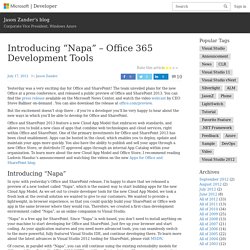

AIIM: Enterprises Not Completely Happy With SharePoint. While recent research by AIIM indicates that at least 70% of organizations have deployed SharePoint in some shape or form over the past year, the way it is being used and the reasons it is being deployed in the first instance, are as many as there are enterprises using it.

However, according to the latest in AIIM’s Industry Watch series report, entitled The SharePoint Puzzle - adding the missing pieces (free after registration), the fact that so many enterprises have a SharePoint presence should not fool people into thinking that it is taking over. Yes, it is present in the majority of companies, but the survey of 551 individual members of the AIIM community that produced 488 responses, shows that many enterprises are also using third-party products to bolster perceived functionality weaknesses in all SharePoint editions, including SharePoint 2010.
The Unanswerable Question. By Christian Buckley , Director of Product Evangelism at Axceler April 16, 2012 - 8:17 PM Current Rating: (0 ratings) One of the most-asked SharePoint questions has absolutely nothing to do with technology: How do we get started?

Whether I am presenting on managed metadata and taxonomy, social computing, governance, or migration planning, someone in the audience inevitably asks this question. It happened again this weekend while presenting my session 'How SharePoint 2010 Stacks up to Your End User Social Media Requirements' at the 3rd annual SharePoint Saturday Los Angeles event.
And for all those who don't use SharePoint, but possibly a competing knowledge management or collaboration platform, these same issues apply. I shared my 'best practices' for how social should work within the enterprise, and hands popped up with questions. Always start your projects by outlining exactly how you plan to manage them. Thriving in a State of SharePoint Governance. According to the initial results of a Microsoft SharePoint governance survey commissioned by Axceler, more than two-thirds of the respondents consider SharePoint governance to be extremely or very important to their organizations. Yet nearly half of those same respondents confirmed that SharePoint governance policies do not exist or are undefined. Governing in a State of SharePoint The state of SharePoint governance today, as indicated by the survey, shows that though SharePoint remains a “strategic enterprise platform” by a majority of respondents (65%), more than half of the organizations surveyed have just started their governance planning efforts, or have not begun them at all.
To help us better understand the misconceptions about governance and best prepare and empower our companies to manage data more effectively, we turned to a former Microsoft insider. In January, Keith Galumbeck was appointed director of the Microsoft practice at Array Information Technology. SharePoint: un-planned, under-developed and un-loved - but not un-popular - SharePoint Community Blog. By Doug Miles , Director Market Intelligence at AIIM July 30, 2012 - 12:44 PM Current Rating: (3 ratings) The latest AIIM Industry Watch report is out today, and it has some great insights into the love/hate relationship between SharePoint and its users.

We asked implementers if they thought SharePoint was the right decision for their business when they originally went for it. It would be easy to focus on the 9% who feel it was a poor decision rather than the 55% who are positive about it – although half of those found it tougher going than they expected. So when we asked, “What are your three biggest on-going business issues with your SharePoint system,” #1, given by 46% or respondents, is the lack of expertise to maximize its usefulness, closely followed at #2 by the lack of strategic plans on what to use it for and what not to – hence the “unplanned and under-developed” title to this piece.
Evolution of SharePoint Project Governance: Best Practices for Today. The Mobile SharePoint Intranet Prioritization Matrix (now in 3D) Intranets can take years to complete and very often never actually reach the stage of total completion; they are in a continuous state of evolution.

With the advent of mobile access from an array of devices, deciding what features to deploy, and how, becomes even more challenging. Intranet Prioritization Matrix Feature requests come from departments, content consumers, content owners, management…the list is endless. With requirements coming from many directions, prioritization is key. All of these requests have to be considered and the benefit of them weighed and put into some kind of prioritization matrix (shown below).
The next step is usually to put together a plan and create a project very often hitting the low hanging fruit and quick wins first. Sharing Is Caring. Or Is It? By , July 29, 2012 - 3:45 PM Current Rating: (2 ratings) When I was consulting on Enterprise Content Management technologies, I became very fond of the “pre-mortem” practice, plan ahead for what going to go wrong. Sharepoint: Who, How and Why We're Using It [Infographic]
Introducing “Napa” - Office 365 Development Tools - Jason Zander's blog. Yesterday was a very exciting day for Office and SharePoint!

The team unveiled plans for the new Office at a press conference, and released a public preview of Office and SharePoint 2013. You can find the press release available on the Microsoft News Center, and watch the video webcast by CEO Steve Ballmer on-demand . You can also download the release at office.com/preview. But the excitement doesn’t stop there – if you’re a developer you’ll be very happy to hear about the new ways in which you’ll be able to develop for Office and SharePoint. Office and SharePoint 2013 feature a new Cloud App Model that embraces web standards, and allows you to build a new class of apps that combine web technologies and cloud services, right within Office and SharePoint. Introducing “Napa” In sync with yesterday’s Office and SharePoint release, I’m happy to share that we released a preview of a new toolset called “Napa”, which is the easiest way to start building apps for the new Cloud App Model.
Run.